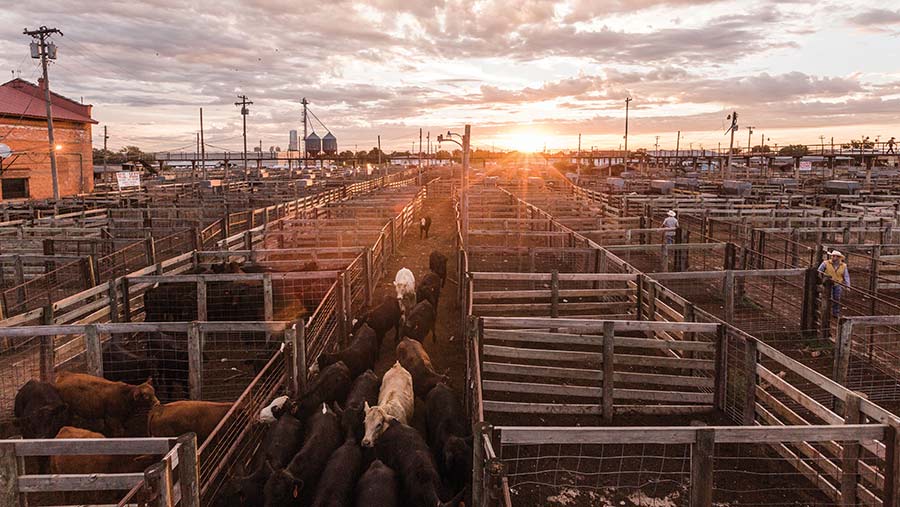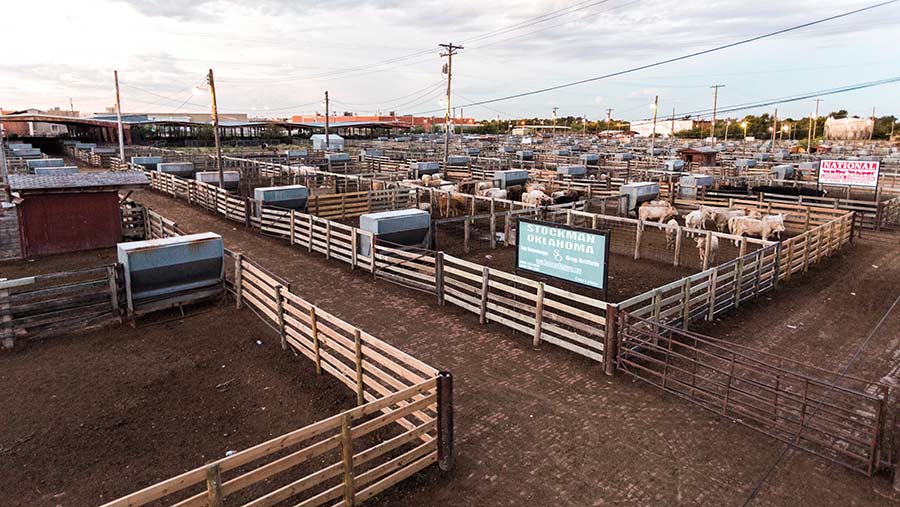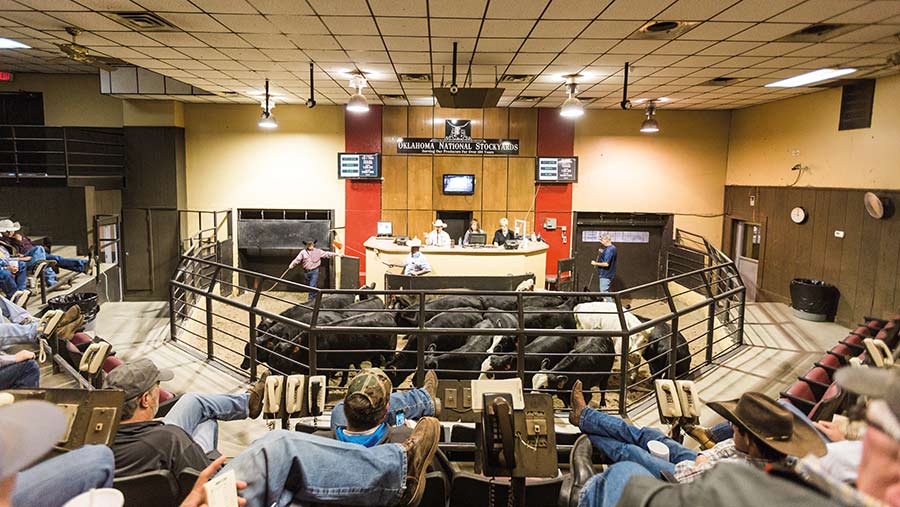A look round the world’s biggest cattle market
 © Oklahoma National Stockyard
© Oklahoma National Stockyard A typical weekly entry of 6,000-10,000-head of calves and store cattle means operations must run like clockwork at Oklahoma National Stockyards (ONS).
Located in the Stockyards City district – the eponymous area that has developed around the stockyard – the 17ha (42-acre) ONS site lies in the heart of the city, south of the Oklahoma river.
Sales consist mainly of commercial calves and stores trading hands between cow/calf (suckler) operations, backgrounder or “stocker” operations and feedlots.
Farmers Weekly spoke to ONS marketing manager Amarie Bartel to learn more about the famous market.
See also: Taking Stock looks back on 50 years of farming
Location
Situated in the central Midwest region, Oklahoma has large open prairie and cow-calf operations and more productive arable farmland to the east, making it a great place for feedlots.
Many feedlots have capacity for 40,000-50,000-head and some more than 300,000-head.
Oklahoma City lies strategically on an intersection of the two biggest interstates (motorways) in the region – the I35 and I40 – which has seen a post-war sale-yard boom after the motor industry expanded.
Sale day
On-site activity often starts two days before a sale, with cattle trucked 1,000 miles or more. On arrival the animals are bedded, fed and watered in pens.
After delivery, the cattle are the responsibility of one of nine commission companies operating at ONS.
These companies earn commission for handling the cattle until stock are loaded up to go onto other ranches and feedlots.
Once sold, cowboys on horseback drive cattle to the pens to be collected and loaded onto wagons. The cost of this is covered by a commission rate on the sale of the cattle.
Levy board Beef Quality Assurance runs training courses in cattle handling. Cowboys only use flags on flexible poles to move cattle, explains Mrs Bartel.

© Oklahoma National Stockyard
How buying works
Commission firms
These companies offer cattle producers expert advice on cattle marketing, just like an auction market fieldsman.
They tell a rancher when calves of a certain weight or type may be needed and when to wait the market out or when to sell on a high.
The stockyard makes a small commission from the cut the commission firms make, as well as renting office space to buyers and commission firms.
- Some companies offer a range of other services, such as finding grazing for cattle, marketing and hedging services on the futures markets, finance, and business consultancy.
- Companies take turns selling cattle until all have been sold or passed on. Each firm gets a limited number of drafts on each turn before they must stop selling and let another company sell, but the firms will continue to rotate as long as necessary.
Selling
Two auctioneers alternate through the day, each doing an hour at a time. The auctioneers are contracted by ONS.
They are not allowed to talk to buyers or vendors, as this could be easily corrupted and conflicts of interest could arise.
Auctioneers are self-employed contractors paid by the stockyard to run the sale and do a little social media work. A US Department of Agriculture market reporter attends every sale.
- Selling starts at 6.30am and often goes on for 12-15 hours.
- The longest day in recent times was in 2019 when a computer failed, and all cattle had to be processed with pen and paper. This sale saw about 17,000-head sold in 23 hours.
- About 800 cattle can be sold in an hour.
- Steers and heifers are sold separately.
Buying
Very few producers attend the sale ring to bid for and buy cattle. The audience is mostly made up of “bonded buyers” (agents) who source cattle for feedlots and farms.
- Buyers must register at the credit desk and be checked over to guarantee funds from a bank. Without insurance company backing, the auctioneer will not take bids from a buyer.
- About 90% of the buyers are there most weeks, with some bonded buyers coming in seasonally as cattle supplies dry up elsewhere.
- All sales can be viewed online, but online bidding is yet to be developed.
Mondays Stockers (weaned calves and young stores) and feeders (forward stores for finishing) are sold. Cattle must be sold in batches of three or more. Larger batches regularly total 75-100-head and are bid for by 50-75 bonded buyers.
Tuesdays Packer (cull) cows and bulls are sold on Tuesdays, along with any “odds” that do not make it into batches on a Monday. Meat packers (processors) buy cattle. Some heifers and cows are sold and taken home by ranchers. Generally, 10-25 buyers compete for cattle.

Sale ring © Oklahoma National Stockyard
Scale of stockyard is ‘a sight to behold’
Tom Runyan has worked in cattle marketing since 1992 for Swift and Henry, a livestock agency and bonded buyer founded in 1909, which operates at ONS.
He has visited Oklahoma City for years to source cattle for producers.
In June 2021, Mr Runyan also started selling and marketing cattle through the market when he became a director of Central Halliburton, which is a commission firm.
“Most commission firms in the sale ring have a cattle buyer operating as well,” says Mr Runyan. “The idea of bonded buyers is to have cover. If buyers can’t pay for cattle, the bond company steps in.
“I will bid on and buy cattle from the selling firm I work for if they fit my buyer’s order. If not, I pass on them. Both the selling firm and buyer charge a commission, but the selling commission is much higher.”
In the early days of cattle trading when Swift and Henry was founded by lawyer JC Swift and accountant Charles D Henry, the commission firm acted like a bank for their ranching customers.
Mr Runyan has been working round the stockyard for decades but says the scale still impresses him. “When you see a whole square mile of full pens on a big sale day, it’s a sight to behold.”
Farmers Weekly says
There are far more parties involved in running a sale yard in the US. These share the risk of operating costs and bad debt.
The traditional British way is to have auctioneers drum up buyers and vendors and run the sale, but this level of involvement is illegal in the US.
Oklahoma National Stockyards facilitates farmer-to-farmer trade of store cattle and weaned calves through professional companies and credit-checked and insured, bonded buyers.
This is very different to British marts, which sell a lot of livestock to the meat trade, which is considered “dodgier” than dealing with farmers.
If half the scrutiny was put on UK market bidders as it is on US store cattle buyers, then the amount of bad debt in the mart system would surely lessen.
